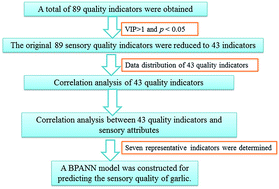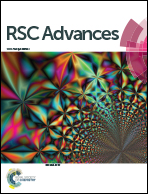A new methodology for sensory quality assessment of garlic based on metabolomics and an artificial neural network†
Abstract
This study has established a new method for the sensory quality determination of garlic and garlic products on the basis of metabolomics and an artificial neural network. A total of 89 quality indicators were obtained, mainly through the metabolomics analysis using gas chromatography/mass spectrometry (GC/MS) and high performance liquid chromatography coupled with tandem mass spectrometry (HPLC-MS/MS). The quality indicator data were standardized and fused at a low level, and then seven representative indicators including the a* (redness) value, and the contents of S-methyl-L-cysteine, 3-vinyl-1,2-dithiacyclohex-5-ene, glutamic acid, L-tyrosine, D-fructose and propene were screened by partial least squares discriminant analysis (PLS-DA), analysis of variance (ANOVA) and correlation analysis (CA). Subsequently, the seven representative indicators were employed as the input data, while the sensory scores for the garlic obtained by a traditional sensory evaluation were regarded as the output data. A back propagation artificial neural network (BPANN) model was constructed for predicting the sensory quality of garlic from four different areas in China. The R2 value of the linear regression equation between the predicted scores and the traditional sensory scores for the garlic was 0.9866, with a mean square error of 0.0034, indicating that the fitting degree was high and that the BPANN model built in this study could predict the sensory quality of garlic accurately. In general, the method developed in this study for the sensory quality determination of garlic and garlic products is rapid, simple and efficient, and can be considered as a potential method for application in quality control in the food industry.



 Please wait while we load your content...
Please wait while we load your content...